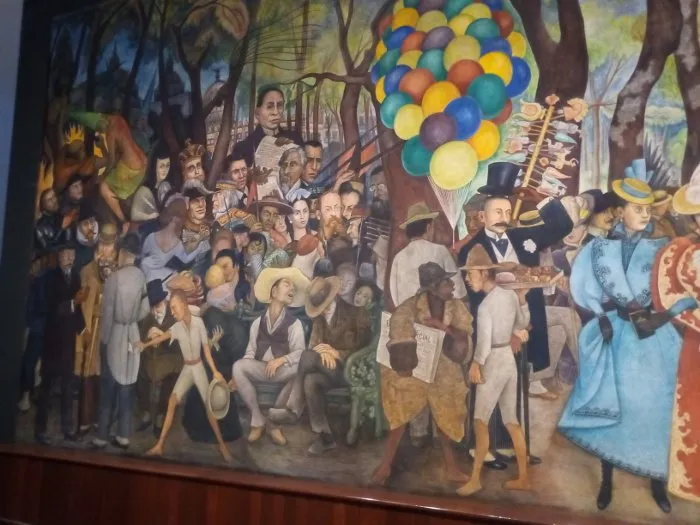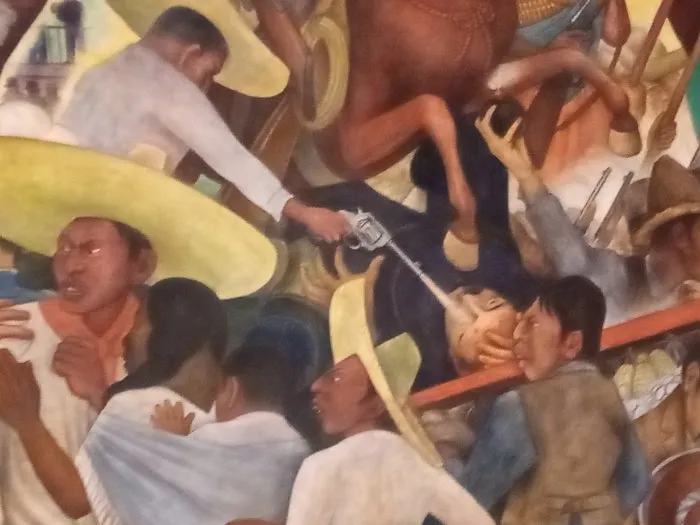After posting about the mural of the Familia Burrón last week, arranged in a setting following the inspiration of a much more famous mural by Diego Rivera, I thought it would be appropriate to actually visit and give it the attention it deserves. After all, the location of this famous painting is right there, next to the Alameda park in the center of Mexico City, which is also where this mural is set. The museum itself is rather small, and at the time of my visit was under reconstruction, so this mural was the only piece on display.



The mural depicts a typical Sunday afternoon around the turn of the century, in what back then was the place to go for the upper classes of Mexico City to see and be seen. It is therefor dominated by ladies and gentlemen wearing their fancy outfits of the time. At a closer look, one will find many interesting elements, symbolizing the colorful history of Mexico, but also the social and political tensions of timelessness of the work, blending past, present and future. Most notably, the painting features prominent historical, as well as contemporary characters.
La Calavera Catrina
At the center of the almost 16 meter (51 feet) long mural we can see La Catrina, a female skeleton dressed in the elegant fashion of a wealthy lady from the turn of the century. Today la Catrina is a highly popular image, representing Mexican tradition and our mortality. Especially around the Day of the Dead you can see her in many drawings, paper-mache figurines, perforated paper sheets, and of course costumes. Interestingly, in this mural she is wearing a feather-boa of the ancient god Quetzalcoatl, the feathered serpent.
Diego and Frida
Although it was this mural that gave the Catrina its popularity, the original image of her goes back to José Guadalupe Posada, a cartoonist from Aguascalientes who was an inspiring force on young Diego Rivera. To pay homage to him, Rivera included him in his mural, walking arm-in-arm with his famous skeleton lady. On her right side the artist placed himself as an adolescent, holding her hand. He is wearing short pants, according to the contemporary custom for boys. The lady behind him is his wife Frida Kahlo, whose fame as an artist surpassed that of her husband. The gentleman behind them lifting his bowler hat is José Martí who is credited for Cuba's independence, but was also a prominent poet who had spent a great deal of time in Mexico. He is just one of the many famous people that have found their way into Rivera's mural. The two ladies in the blue and red dresses are Carmen Romero Rubio de Díaz, and Lucecita Díaz, the wife and daughter of president Porfirio Díaz.
The Times of Porfirio Díaz

The man behind the tranquility of the turn-of-the-century in Mexico was president Porfirio Díaz, often called a dictator for remaining in power for over three decades. You can look at it any way you want, but after the turbulent 19th century, filled with wars, civil wars, invasions, and political upheavals, he brought some welcome stability to the country. In the painting he can be seen in the background, higher than anyone else, to right of the balloon. The balloon, by the way, is piloted by Joaquín de la Cantolla y Rico, Mexico's most famous aeronaut. Below Don Porfirio is the Angel of Independence, another important symbol, who can be seen high up on a pedestal on the iconic Paseo de la Reforma street. In front of her we can see the highly decorated 2nd Lt. Luis Guerrero, a hero of the war with the United States, who became a permanent feature of the Alameda, known simply as General Medals. The lady in the yellow dress is supposed to depict La Revoltosa, a singer, actress, and former lover of Diego River with strong indigenous features, who assumes a challenging stance to the affluent patrons of the Alameda.
The Past of Mexico... And of the Alameda

The left end of the mural takes us back to the distant past of Mexico, to a time just after the conquest, where the Alameda had its origins. The flames in the top of the picture indicate that before it became a park, the area had been used as the burning grounds of the Inquisition. The guy in the in the flat hat is Fray Juan Zumárraga, the first archbishop of Mexico, who established the practice of burning heretics in this place. One of its victims is depicted in front of him, Doña Mariana Violante de Carbajal. She was a prominent Jewish lady who was tortured and burned for heresy. Behind him stands conquistador Hernán Cortéz with blood on his hands, and Viceroy Luis de Velasco II who founded the Alameda park.

Other interesting characters from Mexico's history include Sor Juana Inés de la Cruz a 17th century nun who became renowned for her writings of poetry, philosophy, scientific thought, music, and is today a famous icon for early feminist expression. The crowned head next to her belongs to Augustín de Iturbide, the first Mexican emperor, who reigned for only ten months, right after Mexico's independence. Just below him we can see General Antonio López de Santa Ana who was president eleven times in the short time-span between 1833 and 1855. He is also the one who is commonly blamed for the US invasion, which led to the loss of half the country, from California to Texas. The man looking right at him is US General Winfield Scott, commander of the troops that occupied the Alameda during the invasion. The most important historical character is of course Benito Juarez, credited for his reforms, as well as being the first Mexican president of native origins. Just like Porfirio Díaz, he is standing above everyone else in the background.
From the 19th to the 20th Century
The right half of the mural reaches into the 20th century, and into contemporary times. Note that Rivera painted this picture in the 1940's, and from that perspective it could easily be seen that the new century was the result of the Mexican Revolution. While more violent upheavals have promised social justice, the country was still far from realizing social equality, something that has yet to be achieved, which River made sure to emphasize in his painting.

Quite prominently, in the front of the mural, we can see a policeman swinging a baton at an indigenous peasant family, to keep them out of the Alamade, so they won't provide an eye-sore to the good people of the upper class. While the parents and a young daughter are yielding to this demand, the older son of the family is drawing a knife from his belt, indicating the peasant uprising that would culminate in the revolution.

Just behind this scene it seems like the full violence has been unleashed, where people are being shot by angry Zapatists, and trampled by horses. Further out from this episode of violence, we can see painted banners, and the face of Francisco Madero, the leader of the revolution who became president following Díaz, until he was murdered soon after.
On the right edge of the mural everything seems to come together: traitors of the revolution, such as Victoriano Huerta and Manuel Mondragón are standing next to symbolic characters representing such indistinct figures, as the multimillionaire, the president of the republic and the corrupt law student. These people could be anyone from Rivera's present up to today, who are seen as the forces that keep actual change from happening.
By this point we have entered modern Mexico, indicated by the skyline of tall buildings, where the same age-old problems are overshadowed by the progress of modernity. It is quite appropriate that Rivera included many of his relatives on this side, along with street vendors of tortas and pin-wheels. At this point the setting is really almost like what the Alameda looks like in our times, on any given Sunday afternoon.
If you liked this, check out my developing series on Mexican murals:
- La Familia Burrón in the Center
- Playing With Bugs on the Rooftop
- A Journey Through Rock and Roll
- Elite Warriors in the Parque México
- Laboratory Work on the Cocoa
- High Above the City
- Feminist Mural on a Blue-Collar Business
- Not Much New in Almost a Year
- Commercial Murals for Small Businesses
- A Mural for a Movie
- Get to Know Your Local Cacti
- New Images Covering Old Ones
- A Warrior Princess in Mazunte
- A Cartoon with a Public Health Message
- Murals Under Periferico
- Murals of the Barrio in Aguascalientes
- Respected and Less Respected Paintings
- Under Metro Line 4
- ChaliaKiller's – Murals, Chilaquiles, and Lots More
- A Familiar Face
- Political Expression: the Painting is on the Wall
- Different Types of Wall Paintings
- The Beauty of Death and the Struggle of Life
- Winston Churchill and the Bike Movement
Please check out these great communities I'm contributing to:

#ecotrain | What is EcoTrain | Discord Community

#cyclefeed | Introducing CycleFeed | Discord Community


Introducing SteemitDreamit | Discord Community
